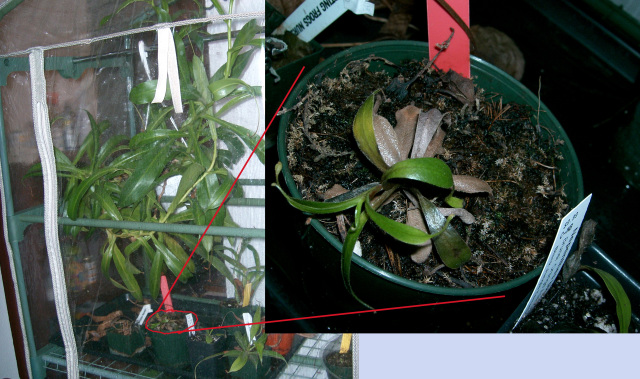Question N. lowii and greenhous
N. lowii and greenhous
QUESTION: I bought a Nepenthes lowii from your nursery, oh many months ago (maybe even close to a year now?) and it has been thriving pretty well up until now. In fact, it was working on several new pitchers! I'm not quite sure what I've done to upset it, but it is suddenly drooping/wilting. The soil hasn't dried out (I just poked it and it seems appropriately damp but not soggy), I haven't moved it in over a month (it's in an indoor "greenhouse" to keep the humidity a bit higher, and by a West facing window), and I spray it once every two weeks (at most) with very dilute fertilizer. All my other Nepenthes (that survived my parents caring for them for a couple months) are doing very well (A ventrata, bicalcarata, and rafflesiana). The only thing I can guess might be upsetting it is that our house has been a bit cooler because of oncoming winter, though lowii is a highlander and shouldn't mind? The other possibility is that it was once recently watered with some pretty cold filtered water out of our fridge?
Do you have any ideas of what is making it unhappy, or what I can do to encourage it to perk up? I'm guessing the cold watering didn't help... :(
ANSWER: Hi Kristina,
Thank you for the photo. This helps me out a lot. First off, the plant could use more sunlight. The stem and leaves look a bit lanky without much color. There should be tinges of bronze in the leaves.
Secondly, stop fertilizing the plant for now. It's never wise to fertilize plants that are sick or not getting sufficient sunlight. Plants need energy to utilize the fertilizer, and they get their energy from sunlight. If lighting is poor, the plant won't use the nutrients, which can end up burning the plant.
Third, change the soil. When you do so, examine the base of the plant. It should feel firm. If so, the plant simply needs new soil and more sunlight. You can also bury the stem a bit to give the plant more support.
However, if the base stem very soft and slightly mushy, the plant may have gotten a bacterial or fungal infection. If this is the case, it might already be too late to salvage the plant. Often when the base stem turns mushy, the infection is too severe. With N. lowii, it's a double whammy because the plant grows incredibly slowly.
Also cut off the dead leaves. This is will help increase air circulation around the base of the plant.
In any case, write back after repotting the plant and examining the base stem.
Good growing!
Jacob Farin
---------- FOLLOW-UP ----------
QUESTION: I've replaced the soil (sand, peat moss, orchid bark mix (couldn't find non-miracle grow perlite for some reason)), trimmed the dead leaves off, and placed the lowii in my south facing garden window in the kitchen, which gets lots of sunlight. The stem right at soil level is woody and pretty solid feeling, however, above the older growth, the stem seems rather ominously floppy and soft. Should I attempt to buy some bacterial/fungicide and hope for the best (and if so, what brand/type would you recommend) or shall I give it up as a lost cause and invest in a new lowii sometime in the future?
AnswerGiven what you've described, the floppy soft growth could be root damage if the soil had gone bad. In this case, cover the plant with a clear plastic cup. What you're doing is creating a humidity dome to prevent excess moisture loss through the leaves. If the roots are damaged or unhealthy, they won't absorb water quick enough to counteract transpiration (moisture loss through the leaves). So the humidity dome will be a crutch until the plant is able to produce a healthier root system, generally within 2 months.
Before placing the cup over the plant, spray it with a sulfur fungicide. You can find it at your local garden center. Follow the directions provided by the manufacturer. You're simply doing this to prevent mold and fungus.
Keep the plant in bright indirect light. Avoid direct sunlight while the plant is under the dome. Monitor the plant periodically for mold and fungus. If necessary, treat with a sulfur fungicide.
After 2 months, acclimate your plant to lower humidity and grow in the appropriate lighting.
Good growing!
Jacob Farin






